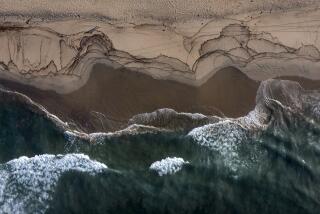BP shoots a stream of cement into damaged well
- Share via
It took BP a mere five hours to pump a stream of cement down its troublesome well Thursday, completing another major step in its final push to end the Gulf of Mexico catastrophe and forever shut down the source of the nation’s largest offshore oil spill.
After jamming the deep-sea well with heavy drilling mud earlier this week, the company began shooting cement down the well at 7:15 a.m. PDT. At 12:15, it issued a two-paragraph statement announcing that it had finished the task and was monitoring the well “to confirm the effectiveness of the procedure.”
Although the cementing should permanently plug at least part of the well bore, federal officials have emphasized that it does not close the book on the troubled well, the cause of one of the nation’s worst environmental disasters.
“This is not the end,” said retired Coast Guard Adm. Thad Allen, who is overseeing the spill operation. “But it will virtually assure us there will be no chance of oil leaking into the environment.”
When the newly poured cement is dry, Allen said BP would finish drilling a relief well that would pierce the base of the damaged well and entomb it with more mud and cement.
The final 100 feet of relief drilling will be conducted in increments as engineers painstakingly aim at a pipe — no wider than a dinner plate — that is buried miles under the seabed.
It probably will be mid-August before the relief operation is over and the well has been officially “killed.”
“I am the national incident commander. I issue the orders. This will not be done until we complete the bottom,” Allen said Thursday morning as the cementing was underway.
Since the well 50 miles off the Louisiana coast was mechanically capped three weeks ago, no oil has leaked into the gulf. Slicks have shrunk substantially, and offshore cleanup crews are shifting their attention to coastal areas.
“There is very little observable oil out there,” Rear Adm. Paul Zunkunft, the federal on-scene coordinator, said at a news briefing. Nor, he added, is underwater testing finding much evidence of hydrocarbons.
A federal report released Wednesday indicated that roughly half of the more than 200 million gallons of oil that gushed from the well before it was capped could still be in the gulf environment in some form: as tiny dispersed droplets, tar balls, surface slicks or oil buried in sand and ocean sediment.
“If we don’t see oil, I am not assuming it doesn’t exist,” Zunkunft said.
“Right now I am not downsizing anything,” he added. “I have the largest concentration of offshore skimmers in the world. They are still on retainer and will be so until we have a permanent kill.”
On Thursday, Rep. Edward J. Markey (D-Mass.), chairman of the House Energy and Environment Subcommittee, released a letter from the Food and Drug Administration in which the agency says it has no evidence that the chemical dispersants used to break up the BP spill have contaminated seafood.
Comparing the final stages of the relief-well operation to drilling into a tree trunk, Allen said the outer ring of the well, called the annulus, will be intersected first. “Once we get in there, we will know how much of an effect we’ve had with the mud and the cement from the top,” he said.
The likely scenario, Allen said, is that more mud and cement will be pumped into the annulus and allowed to harden. Then the inner ring, the well casing, will be penetrated and, if necessary, mud and cement will be shot into its lower portion.
The goal, he explained, is to permanently plug every conceivable route that oil could take to the surface from its reservoir miles beneath the gulf floor.
bettina.boxall@latimes.com
margot.roosevelt@latimes.com
More to Read
Sign up for Essential California
The most important California stories and recommendations in your inbox every morning.
You may occasionally receive promotional content from the Los Angeles Times.















